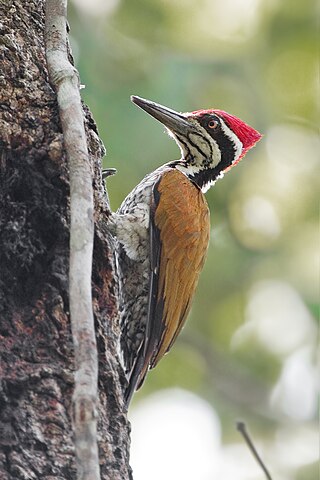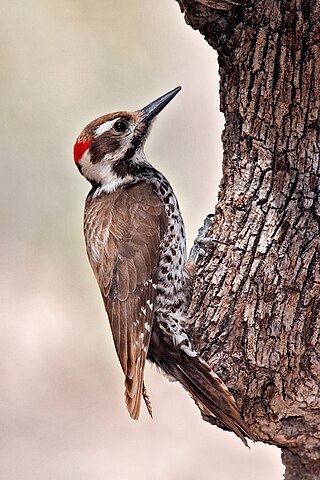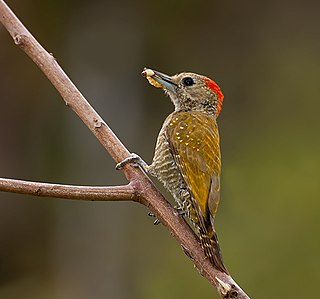
The hairy woodpecker is a medium-sized woodpecker that is found over a large area of North America. It is approximately 250 mm (9.8 in) in length with a 380 mm (15 in) wingspan. With an estimated population in 2020 of almost nine million individuals, the hairy woodpecker is listed by the IUCN as a species of least concern. Some nomenclature authorities, such as the eBird/Clements checklist, place this species in the genus Dryobates.

The red-breasted sapsucker is a medium-sized woodpecker of the forests of the west coast of North America.

The white-breasted nuthatch is a species of bird in the nuthatch family Sittidae. It is a medium-sized nuthatch, measuring approximately 15.5 cm (6.1 in) in length. Coloration varies somewhat along the species' range, but the upperparts are light blue-gray, with a black crown and nape in males, while females have a dark gray crown. The underparts are whitish, with a reddish tinge on the lower abdomen. Despite not being closely related, the white-breasted nuthatch and the white wagtail are very similar in plumage. The white-breasted nuthatch is a noisy bird. It has a nasal voice and often utters little cries or vocalizations, often composed of repetitions of small invariant whistles. In summer, it is an exclusively insectivorous bird, consuming a wide range of arthropods, but in winter its diet consists mainly of seeds. The nest is located in the cavity of a tree. The clutch consists of five to nine eggs, incubated for two weeks by the female, who is fed by the male. The two adults then feed the young until they fledge, and for a few weeks after that.

The African grey woodpecker is a species of bird in the woodpecker family Picidae. Is a widespread and frequently common resident breeder in much of Sub-Saharan and equatorial Africa. It is a species associated with forest and bush which nests in a tree hole, often in an oil palm, laying two to four eggs. It is a common bird with a very wide range, and the International Union for Conservation of Nature has rated its conservation status as being of "least concern".

The greater flameback also known as greater goldenback, large golden-backed woodpecker is a woodpecker species. It occurs widely in the northern Indian subcontinent, eastwards to southern China, the Malay Peninsula, Sumatra, western and central Java and northeast Borneo.

The red-cockaded woodpecker is a woodpecker endemic to the southeastern United States.

The golden-fronted woodpecker is a species of bird in subfamily Picinae of the woodpecker family Picidae. It is found in the southern United States, Mexico and parts of Central America.

The white-headed woodpecker is a non-migratory woodpecker that resides in pine forests of the mountains of western North America.

The Arizona woodpecker is a woodpecker native to southern Arizona and New Mexico and the Sierra Madre Occidental of western Mexico. The species' northernmost range in southeastern Arizona, extreme southwestern New Mexico, and northern Sonora is the region of the Madrean Sky Islands, a region of higher Sonoran Desert mountain ranges.

The black-cheeked woodpecker is a species of bird in subfamily Picinae of the woodpecker family Picidae. It is found from Mexico south to Ecuador.

The cardinal woodpecker is a widespread and common resident breeder in much of sub-Saharan Africa. It occurs in a wide range of habitats, ranging from dense forest to thorn bush. It is fairly vocal and is easily identified by its call notes. The sexes are distinguishable by their head patterns.

The little woodpecker is a species of bird in subfamily Picinae of the woodpecker family Picidae. It is found in every mainland South American country except Chile, Suriname, and Uruguay.

The waved woodpecker is a species of bird in subfamily Picinae of the woodpecker family Picidae. It is found in Bolivia, Brazil, Colombia, Ecuador, French Guiana, Guyana, Peru, Suriname, and Venezuela.

The black-necked woodpecker or black-necked flicker is a species of bird in subfamily Picinae of the woodpecker family Picidae. It is endemic to Peru.

The green-barred woodpecker or green-barred flicker is a species of bird in subfamily Picinae of the woodpecker family Picidae. It is found in Argentina, Bolivia, Brazil, Paraguay and Uruguay.

The brown-backed woodpecker is a species of bird in the woodpecker family Picidae. It is found in a belt across the savannah region of sub-Saharan Africa from Senegal in the west to Ethiopia, Kenya and Tanzania in the east. It is generally uncommon, but has a very large range and the population appears to be steady, so the International Union for Conservation of Nature has rated its conservation status as being of "least concern".

The Jamaican woodpecker is a species of bird in subfamily Picinae of the woodpecker family Picidae. It is endemic to Jamaica.

The white-throated woodpecker is a species of bird in subfamily Picinae of the woodpecker family Picidae. It is found Bolivia, Brazil, Colombia, Ecuador, and Peru.

The bronze-winged woodpecker is a species of bird in subfamily Picinae of the woodpecker family Picidae. It is endemic to northeastern Mexico.

Leuconotopicus is a genus of woodpeckers in the family Picidae native to North and South America.






















